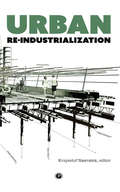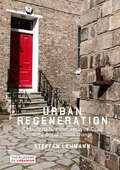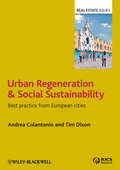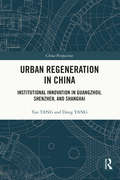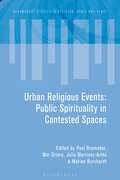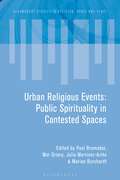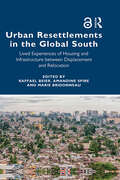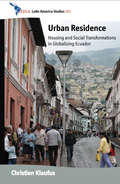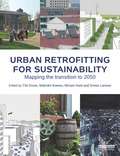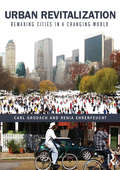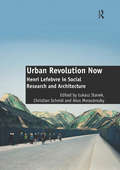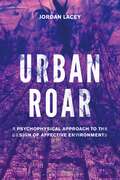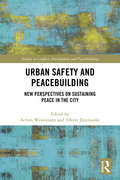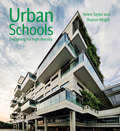- Table View
- List View
Urban Re-industrialization (PDF)
by Krzysztof NawratekUrban re-industrialisation could be seen as a method of increasing business effectiveness in the context of a politically stimulated ‘green economy’; it could also be seen as a nostalgic mutation of a creative-class concept, focused on 3D printing, ‘boutique manufacturing’ and crafts. These two notions place urban re-industrialisation within the context of the current neoliberal economic regime and urban development based on property and land speculation. Could urban re-industrialisation be a more radical idea? Could urban re-industrialization be imagined as a progressive socio-political and economic project, aimed at creating an inclusive and democratic society based on cooperation and a symbiosis that goes way beyond the current model of a neoliberal city? In January 2012, against the backdrop of the 2008 financial crisis, Krzysztof Nawratek published a text in opposition to the fantasy of a ‘cappuccino city,’ arguing that the post-industrial city is a fiction, and that it should be replaced by ‘Industrial City 2.0.’ Industrial City 2.0 is an attempt to see a post-socialist and post-industrial city from another perspective, a kind of negative of the modernist industrial city. If, for logistical reasons and because of a concern for the health of residents, modernism tried to separate different functions from each other (mainly industry from residential areas), Industrial City 2.0 is based on the ideas of coexistence, proximity, and synergy. The essays collected here envision the possibilities (as well as the possible perils) of such a scheme.
Urban Regeneration: A Manifesto for transforming UK Cities in the Age of Climate Change
by Steffen LehmannUrban Regeneration — A Manifesto for transforming UK Cities in the Age of Climate Change explores and offers guidance on the complex process of how to transform cities, continuing the unfinished project of the seminal 1999 text Towards an Urban Renaissance. It is a 21st-century manifesto of urban principles compiled by a prominent urbanist, for the regeneration of UK cities, focusing on the characteristics of a ‘good place’ and the strategies of sustainable urbanism. It asks readers to consider how we can best transform the derelict, abandoned and run-down parts of cities back into places where people want to live, work and play.The book frames an architecture of re-use that translates and combines the complex ‘science of cities’ and the art of urban and architectural design into actionable and practical guidance on how to regenerate cities. Fascinated by the typology and value of the compact UK and European city model, Lehmann introduces the concept of ‘high density without high buildings’ as a solution that will make our cities compact, walkable, mixed-use and vibrant again.
Urban Regeneration and Social Sustainability: Best Practice from European Cities (Real Estate Issues #53)
by Andrea Colantonio Tim DixonUrban regeneration is a key focus for public policy throughout Europe. This book examines social sustainability and analyses its meaning. The authors offer a comprehensive European perspective to identify best practices in sustainable urban regeneration in five major cities in Spain, Italy, Netherlands, Germany, and the UK. This authoritative overview of the scholarly literature makes the book essential reading for researchers and post-graduate students in sustainable development, real estate, geography, urban studies, and urban planning, as well as consultants and policy advisors in urban regeneration and the built environment.
Urban Regeneration and Social Sustainability: Best Practice from European Cities (Real Estate Issues)
by Andrea Colantonio Tim DixonUrban regeneration is a key focus for public policy throughout Europe. This book examines social sustainability and analyses its meaning. The authors offer a comprehensive European perspective to identify best practices in sustainable urban regeneration in five major cities in Spain, Italy, Netherlands, Germany, and the UK. This authoritative overview of the scholarly literature makes the book essential reading for researchers and post-graduate students in sustainable development, real estate, geography, urban studies, and urban planning, as well as consultants and policy advisors in urban regeneration and the built environment.
Urban Regeneration in China: Institutional Innovation in Guangzhou, Shenzhen, and Shanghai (China Perspectives)
by Yan Tang Dong YangThe book examines institutional innovation in urban regeneration in Guangzhou, Shenzhen, and Shanghai, three Chinese cities that have experienced sweeping changes in recent years, providing an ideal guide to the development of urban regeneration practices in China. As a starting point, the book revisits relevant theoretical developments and the institutional experiences of urban regeneration in some Asian pioneer cities and regions, such as Hong Kong, Taipei, Tokyo, and Singapore. Moving on to the Chinese mainland cities themselves, the core comparative study investigates the institutional systems, key policies, planning formulations, and implementation paths in the urban regeneration process of the three cities. Gains and losses that have resulted from each city's institutional construction and reformation are discussed, as well as the underlying reasons for these. Drawing on these case studies and comparisons, the book puts forward some generic rules for urban regeneration institutional innovation, offering a valuable frame of reference for other cities and regions. The book will appeal to scholars interested in urban regeneration and renewal, as well as urban planners, architects, policymakers, and urban development administrators.
Urban Regeneration in China: Institutional Innovation in Guangzhou, Shenzhen, and Shanghai (China Perspectives)
by Yan Tang Dong YangThe book examines institutional innovation in urban regeneration in Guangzhou, Shenzhen, and Shanghai, three Chinese cities that have experienced sweeping changes in recent years, providing an ideal guide to the development of urban regeneration practices in China. As a starting point, the book revisits relevant theoretical developments and the institutional experiences of urban regeneration in some Asian pioneer cities and regions, such as Hong Kong, Taipei, Tokyo, and Singapore. Moving on to the Chinese mainland cities themselves, the core comparative study investigates the institutional systems, key policies, planning formulations, and implementation paths in the urban regeneration process of the three cities. Gains and losses that have resulted from each city's institutional construction and reformation are discussed, as well as the underlying reasons for these. Drawing on these case studies and comparisons, the book puts forward some generic rules for urban regeneration institutional innovation, offering a valuable frame of reference for other cities and regions. The book will appeal to scholars interested in urban regeneration and renewal, as well as urban planners, architects, policymakers, and urban development administrators.
Urban Religious Events: Public Spirituality in Contested Spaces (Bloomsbury Studies in Religion, Space and Place)
by Paul Bramadat, Mar Griera, Julia Martínez-Ariño and Marian BurchardtHow might we best understand the relationship between the vibrant religious landscapes we see in many cities and contemporary urban social processes? Through case studies drawn from around the world, contributors explore the ways in which these processes interact in cities. This book argues that religious events – including rituals, processions, and festivals – are not only choreographies of sacred traditions, but they are also creative disruptions that reveal how urban cultural hierarchies are experienced and contested. Exposing the power dynamics behind these events, this book shows how performative uses of urban space serve to destabilize dominant genealogies and lineages around urban identities just as they lay claims to cultural supremacy or heritage. Through exploring the affective disruptions and political controversies caused by religious events, the contributors engage theoretical discussions in urban studies, the sociology of religion and the ethnography of ritual. This book is a significant contribution to understanding emerging patterns in contemporary religion and also for theories related to heritagization, eventization, and urbanization.
Urban Religious Events: Public Spirituality in Contested Spaces (Bloomsbury Studies in Religion, Space and Place)
How might we best understand the relationship between the vibrant religious landscapes we see in many cities and contemporary urban social processes? Through case studies drawn from around the world, contributors explore the ways in which these processes interact in cities. This book argues that religious events – including rituals, processions, and festivals – are not only choreographies of sacred traditions, but they are also creative disruptions that reveal how urban cultural hierarchies are experienced and contested. Exposing the power dynamics behind these events, this book shows how performative uses of urban space serve to destabilize dominant genealogies and lineages around urban identities just as they lay claims to cultural supremacy or heritage. Through exploring the affective disruptions and political controversies caused by religious events, the contributors engage theoretical discussions in urban studies, the sociology of religion and the ethnography of ritual. This book is a significant contribution to understanding emerging patterns in contemporary religion and also for theories related to heritagization, eventization, and urbanization.
Urban Renewal in Central Seoul: Planning Paradigm Shifts (Routledge Research in Sustainable Planning and Development in Asia)
by Hyung Min KimKim details a brief history of urban renewal in central Seoul through articulating urban planning paradigm shifts. This book illustrates four main themes in central Seoul: the restoration of the Cheonggye stream, the redevelopment of the Sewoon Plaza, the enhancement of walkability and public transport networks, and history- centred urban renewal.Urban renewal is seen as a remedy for urban sprawl and is appreciated for its capacity to make use of pre-existing infrastructure and cultural assets in high- density urban areas. However, it faces critical challenges, such as fragmented property ownership and escalated land prices in comparison with peri- urban areas. The book focuses on how planning policies have shaped the urban renewal process in central Seoul, South Korea. Spatial development policies for central Seoul have been changed from modern transport facilities, post- war reconstruction, informality, industrialisation to walkability, sustainability, and social cohesion in line with economic restructuring. In recent times, there has been a significant change in thinking towards creating public spaces for walking, preserving historical sites and heritage, and maintaining green spaces. These interconnected topics contribute to understanding the complexity of urban renewal.This book is a useful read for researchers on urban planning and policies who are keen to understand the complicated process of urban renewal and ways to revitalise economic and human activities and transform built environments.
Urban Renewal in Central Seoul: Planning Paradigm Shifts (Routledge Research in Sustainable Planning and Development in Asia)
by Hyung Min KimKim details a brief history of urban renewal in central Seoul through articulating urban planning paradigm shifts. This book illustrates four main themes in central Seoul: the restoration of the Cheonggye stream, the redevelopment of the Sewoon Plaza, the enhancement of walkability and public transport networks, and history- centred urban renewal.Urban renewal is seen as a remedy for urban sprawl and is appreciated for its capacity to make use of pre-existing infrastructure and cultural assets in high- density urban areas. However, it faces critical challenges, such as fragmented property ownership and escalated land prices in comparison with peri- urban areas. The book focuses on how planning policies have shaped the urban renewal process in central Seoul, South Korea. Spatial development policies for central Seoul have been changed from modern transport facilities, post- war reconstruction, informality, industrialisation to walkability, sustainability, and social cohesion in line with economic restructuring. In recent times, there has been a significant change in thinking towards creating public spaces for walking, preserving historical sites and heritage, and maintaining green spaces. These interconnected topics contribute to understanding the complexity of urban renewal.This book is a useful read for researchers on urban planning and policies who are keen to understand the complicated process of urban renewal and ways to revitalise economic and human activities and transform built environments.
Urban Resettlements in the Global South: Lived Experiences of Housing and Infrastructure between Displacement and Relocation
by Raffael BeierUrban Resettlements in the Global South provides new perspectives on resettlement through an urban studies lens. To date, resettlement has been theorised through development studies and refugee studies, but urban resettlement is also a major dimension of urban development in the Global South and may help to rethink contemporary urban dynamics between spectacular new town developments and rising incidences of eviction and displacement. Conceptualising resettlement as a binding notion between production/regeneration and destruction/demolition of urban space helps to illuminate interdependencies and to underline significant ambiguities within affected people’s perspectives towards resettlement projects. This volume will offer an interesting selection of ten different case studies with rich empirical data from Latin America, North and Sub-Saharan Africa, and Asia, focused on each stage of resettlement (before, during, after relocation) through different timescales. By offering a frame for analysing and rethinking resettlement within urban studies, it will support any scholar or expert dealing with resettlement, displacement, and housing in an urban context, seeking to improve housing and planning policies in and for the city.
Urban Resettlements in the Global South: Lived Experiences of Housing and Infrastructure between Displacement and Relocation
by Raffael Beier Amandine Spire Marie BridonneauUrban Resettlements in the Global South provides new perspectives on resettlement through an urban studies lens. To date, resettlement has been theorised through development studies and refugee studies, but urban resettlement is also a major dimension of urban development in the Global South and may help to rethink contemporary urban dynamics between spectacular new town developments and rising incidences of eviction and displacement. Conceptualising resettlement as a binding notion between production/regeneration and destruction/demolition of urban space helps to illuminate interdependencies and to underline significant ambiguities within affected people’s perspectives towards resettlement projects. This volume will offer an interesting selection of ten different case studies with rich empirical data from Latin America, North and Sub-Saharan Africa, and Asia, focused on each stage of resettlement (before, during, after relocation) through different timescales. By offering a frame for analysing and rethinking resettlement within urban studies, it will support any scholar or expert dealing with resettlement, displacement, and housing in an urban context, seeking to improve housing and planning policies in and for the city.
Urban Residence: Housing and Social Transformations in Globalizing Ecuador (CEDLA Latin America Studies #100)
by Christien KlaufusRiobamba and Cuenca, two intermediate cities in Ecuador, have become part of global networks through transnational migration, incoming remittances, tourism, and global economic connections. Their landscape is changing in several significant ways, a reflection of the social and urban transformations occurring in contemporary Ecuadorian society. Exploring the discourses and actions of two contrasting population groups, rarely studied in tandem, within these cities—popular-settlement residents and professionals in the planning and construction sector—this study analyzes how each is involved in house designs and neighborhood consolidation. Ideas, ambitions, and power relations come into play at every stage of the production and use of urban space, and as a result individual decisions about both house designs and the urban layout influence the development of the urban fabric. Knowledge about intermediate cities is crucial in order to understand current trends in the predominantly urban societies of Latin America, and this study is an example of needed interdisciplinary scholarship that contributes to the fields of urban studies, urban anthropology, sociology, and architecture.
Urban Retrofitting for Sustainability: Mapping the Transition to 2050
by Tim Dixon Malcolm Eames Miriam Hunt Simon LannonWith a foreword from Paul King, Chief Executive, UK Green Building Council and Chairman, Zero Carbon Hub As concerns over climate change and resource constraints grow, many cities across the world are trying to achieve a low carbon transition. Although new zero carbon buildings are an important part of the story, in existing cities the transformation of the current building stock and urban infrastructure must inevitably form the main focus for transitioning to a low carbon and sustainable future by 2050. Urban Retrofitting for Sustainability brings together interdisciplinary research contributions from leading international experts to focus on key issues such as systems innovation, financing tools, governance, energy, and water management. The chapters consider not only the knowledge and technical tools available, but looks forward to how they can be implemented in real cities by 2050.
Urban Retrofitting for Sustainability: Mapping the Transition to 2050
by Tim Dixon Malcolm Eames Miriam Hunt Simon LannonWith a foreword from Paul King, Chief Executive, UK Green Building Council and Chairman, Zero Carbon Hub As concerns over climate change and resource constraints grow, many cities across the world are trying to achieve a low carbon transition. Although new zero carbon buildings are an important part of the story, in existing cities the transformation of the current building stock and urban infrastructure must inevitably form the main focus for transitioning to a low carbon and sustainable future by 2050. Urban Retrofitting for Sustainability brings together interdisciplinary research contributions from leading international experts to focus on key issues such as systems innovation, financing tools, governance, energy, and water management. The chapters consider not only the knowledge and technical tools available, but looks forward to how they can be implemented in real cities by 2050.
Urban Revitalization: Remaking cities in a changing world
by Carl Grodach Renia EhrenfeuchtFollowing decades of neglect and decline, many US cities have undergone a dramatic renaissance. From New York to Nashville and Pittsburgh to Portland governments have implemented innovative redevelopment strategies to adapt to a globally integrated, post-industrial economy and cope with declining industries, tax bases, and populations. However, despite the prominence of new amenities in revitalized neighborhoods, spectacular architectural icons, and pedestrian friendly entertainment districts, the urban comeback has been highly uneven. Even thriving cities are defined by a bifurcated population of creative class professionals and a low-wage, low-skilled workforce. Many are home to diverse and thriving immigrant communities, but also contain economically and socially segregated neighborhoods. They have transformed high-profile central city brownfields, but many disadvantaged neighborhoods continue to grapple with abandoned and environmentally contaminated sites. As urban cores boom, inner-ring suburban areas increasingly face mounting problems, while other shrinking cities continue to wrestle with long-term decline. The Great Recession brought additional challenges to planning and development professionals and community organizations alike as they work to maintain successes and respond to new problems. It is crucial that students of urban revitalization recognize these challenges, their impacts on different populations, and the implications for crafting effective and equitable revitalization policy. Urban Revitalization: Remaking Cities in a Changing World will be a guide in this learning process. This textbook will be the first to comprehensively and critically synthesize the successful approaches and pressing challenges involved in urban revitalization. The book is divided into five sections. In the introductory section, we set the stage by providing a conceptual framework to understand urban revitalization that links a political economy perspective with an appreciation of socio-cultural factors in explaining urban change. Stemming from this, we will explain the significance of revitalization and present a summary of the key debates, issues and conflicts surrounding revitalization efforts. Section II will examine the historical causes for decline in central city and inner-ring suburban areas and shrinking cities and, building from the conceptual framework, discuss theory useful to explain the factors that shape contemporary revitalization initiatives and outcomes. Section III will introduce students to the analytical techniques and key data sources for urban revitalization planning. Section IV will provide an in-depth, criticaldiscussion of contemporary urban revitalization policies, strategies, and projects. This section will offer a rich set of case studies that contextualize key themes and strategic areas across a range of contexts including the urban core, central city neighborhoods, suburban areas, and shrinking cities. Lastly, Section V concludes by reflecting on the current state of urban revitalization planning and the emerging challenges the field must face in the future.Urban Revitalization will integrate academic and policy research with professional knowledge and techniques. Its key strength will be the combination of a critical examination of best practices and innovative approaches with an overview of the methods used to understand local situations and urban revitalization processes. A unique feature will be chapter-specific case studies of contemporary urban revitalization projects and questions geared toward generatingclassroom discussion around key issues. The book will be written in an accessible style and thoughtfully organized to provide graduate and upper-level undergraduate students with a comprehensive resource that will also serve as a reference guide for professionals
Urban Revitalization: Remaking cities in a changing world
by Carl Grodach Renia EhrenfeuchtFollowing decades of neglect and decline, many US cities have undergone a dramatic renaissance. From New York to Nashville and Pittsburgh to Portland governments have implemented innovative redevelopment strategies to adapt to a globally integrated, post-industrial economy and cope with declining industries, tax bases, and populations. However, despite the prominence of new amenities in revitalized neighborhoods, spectacular architectural icons, and pedestrian friendly entertainment districts, the urban comeback has been highly uneven. Even thriving cities are defined by a bifurcated population of creative class professionals and a low-wage, low-skilled workforce. Many are home to diverse and thriving immigrant communities, but also contain economically and socially segregated neighborhoods. They have transformed high-profile central city brownfields, but many disadvantaged neighborhoods continue to grapple with abandoned and environmentally contaminated sites. As urban cores boom, inner-ring suburban areas increasingly face mounting problems, while other shrinking cities continue to wrestle with long-term decline. The Great Recession brought additional challenges to planning and development professionals and community organizations alike as they work to maintain successes and respond to new problems. It is crucial that students of urban revitalization recognize these challenges, their impacts on different populations, and the implications for crafting effective and equitable revitalization policy. Urban Revitalization: Remaking Cities in a Changing World will be a guide in this learning process. This textbook will be the first to comprehensively and critically synthesize the successful approaches and pressing challenges involved in urban revitalization. The book is divided into five sections. In the introductory section, we set the stage by providing a conceptual framework to understand urban revitalization that links a political economy perspective with an appreciation of socio-cultural factors in explaining urban change. Stemming from this, we will explain the significance of revitalization and present a summary of the key debates, issues and conflicts surrounding revitalization efforts. Section II will examine the historical causes for decline in central city and inner-ring suburban areas and shrinking cities and, building from the conceptual framework, discuss theory useful to explain the factors that shape contemporary revitalization initiatives and outcomes. Section III will introduce students to the analytical techniques and key data sources for urban revitalization planning. Section IV will provide an in-depth, criticaldiscussion of contemporary urban revitalization policies, strategies, and projects. This section will offer a rich set of case studies that contextualize key themes and strategic areas across a range of contexts including the urban core, central city neighborhoods, suburban areas, and shrinking cities. Lastly, Section V concludes by reflecting on the current state of urban revitalization planning and the emerging challenges the field must face in the future.Urban Revitalization will integrate academic and policy research with professional knowledge and techniques. Its key strength will be the combination of a critical examination of best practices and innovative approaches with an overview of the methods used to understand local situations and urban revitalization processes. A unique feature will be chapter-specific case studies of contemporary urban revitalization projects and questions geared toward generatingclassroom discussion around key issues. The book will be written in an accessible style and thoughtfully organized to provide graduate and upper-level undergraduate students with a comprehensive resource that will also serve as a reference guide for professionals
Urban Revolution Now: Henri Lefebvre in Social Research and Architecture
by Christian SchmidWhen Henri Lefebvre published The Urban Revolution in 1970, he sketched a research itinerary on the emerging tendency towards planetary urbanization. Today, when this tendency has become reality, Lefebvre’s ideas on everyday life, production of space, rhythmanalysis and the right to the city are indispensable for the understanding of urbanization processes at every scale of social practice. This volume is the first to develop Lefebvre’s concepts in social research and architecture by focusing on urban conjunctures in Barcelona, Belgrade, Berlin, Budapest, Copenhagen, Dhaka, Hong Kong, London, New Orleans, Nowa Huta, Paris, Toronto, São Paulo, Sarajevo, as well as in Mexico and Switzerland. With contributions by historians and theorists of architecture and urbanism, geographers, sociologists, political and cultural scientists, Urban Revolution Now reveals the multiplicity of processes of urbanization and the variety of their patterns and actors around the globe.
Urban Revolution Now: Henri Lefebvre in Social Research and Architecture
by Christian SchmidWhen Henri Lefebvre published The Urban Revolution in 1970, he sketched a research itinerary on the emerging tendency towards planetary urbanization. Today, when this tendency has become reality, Lefebvre’s ideas on everyday life, production of space, rhythmanalysis and the right to the city are indispensable for the understanding of urbanization processes at every scale of social practice. This volume is the first to develop Lefebvre’s concepts in social research and architecture by focusing on urban conjunctures in Barcelona, Belgrade, Berlin, Budapest, Copenhagen, Dhaka, Hong Kong, London, New Orleans, Nowa Huta, Paris, Toronto, São Paulo, Sarajevo, as well as in Mexico and Switzerland. With contributions by historians and theorists of architecture and urbanism, geographers, sociologists, political and cultural scientists, Urban Revolution Now reveals the multiplicity of processes of urbanization and the variety of their patterns and actors around the globe.
Urban Roar: A Psychophysical Approach to the Design of Affective Environments
by Jordan LaceyUrban Roar argues for the existence of 'autonomous affectivities' that roar beneath the din of the urban, seeking the attention of us humans so captured by the environments of our own making. In hearing the urban roar, it is the mythic intention of this book to discover ways in which we can work with the intensities of more-than-human forces to vitalize our cities. The book explores methods by which artists, particularly those sound artists involved in fieldwork practices, might encounter and translate autonomous affectivities between different environments. Of particular interest is Jung's concept of synchronicity and its relationship to artistic creation – as experience, flow and catalyst – in manifesting autonomous affectivities into diverse and affective environments. The book makes use of both theoretical and practical approaches: from a study of scholarship through which it is argued that an autonomous affectivity is equivalent to an archetype (via Jung) and an essence (via Deleuze's reading of Spinoza), to theoretical considerations of the situated body in everyday contexts, to practical study of an artistic research experiment designed to reveal and index autonomous affectivities encountered during fieldwork practices, for the purpose of influencing urban design interventions. In this fresh analysis, Lacey reveals the possibilities in urban environments.
Urban Roar: A Psychophysical Approach to the Design of Affective Environments
by Jordan LaceyUrban Roar argues for the existence of 'autonomous affectivities' that roar beneath the din of the urban, seeking the attention of us humans so captured by the environments of our own making. In hearing the urban roar, it is the mythic intention of this book to discover ways in which we can work with the intensities of more-than-human forces to vitalize our cities. The book explores methods by which artists, particularly those sound artists involved in fieldwork practices, might encounter and translate autonomous affectivities between different environments. Of particular interest is Jung's concept of synchronicity and its relationship to artistic creation – as experience, flow and catalyst – in manifesting autonomous affectivities into diverse and affective environments. The book makes use of both theoretical and practical approaches: from a study of scholarship through which it is argued that an autonomous affectivity is equivalent to an archetype (via Jung) and an essence (via Deleuze's reading of Spinoza), to theoretical considerations of the situated body in everyday contexts, to practical study of an artistic research experiment designed to reveal and index autonomous affectivities encountered during fieldwork practices, for the purpose of influencing urban design interventions. In this fresh analysis, Lacey reveals the possibilities in urban environments.
Urban Safety and Peacebuilding: New Perspectives on Sustaining Peace in the City (Studies in Conflict, Development and Peacebuilding)
by Achim Wennmann Oliver JutersonkeThis volume draws together original research related to conceptual and practical advances at the interface of urban safety and peacebuilding. The book reflects the advances in urban safety and peacebuilding to help address the rapidly increasing risk of conflict and insecurity in cities. Specifically, it draws on contributions to the Technical Working Group on the Confluence of Urban Safety and Peacebuilding Practice, an informal expert network co-facilitated by the United Nations Office at Geneva, UN-Habitat’s Safer Cities Programme, and the Geneva Peacebuilding Platform. A focus on ‘sustaining peace’ serves as a framework for situating new policy responses against conflict, violence, and exclusion in the city, and for promoting a conversation across disciplinary and specialist silos. The volume thereby broadens the optic of peacebuilding practice beyond interstate and intrastate armed conflicts – and especially their aftermath – and reconnects it to the community-level origins of building peace. The analysis and practice presented here will remind those willing to work towards peaceful and inclusive cities that there are tried and tested approaches available, and a host of experts and practitioners ready to accompany those prepared to lead in their respective contexts. This book will be of interest to students and researchers in the fields of peacebuilding, urban studies, security studies, and international relations.
Urban Safety and Peacebuilding: New Perspectives on Sustaining Peace in the City (Studies in Conflict, Development and Peacebuilding)
by Achim Wennmann Oliver JütersonkeThis volume draws together original research related to conceptual and practical advances at the interface of urban safety and peacebuilding. The book reflects the advances in urban safety and peacebuilding to help address the rapidly increasing risk of conflict and insecurity in cities. Specifically, it draws on contributions to the Technical Working Group on the Confluence of Urban Safety and Peacebuilding Practice, an informal expert network co-facilitated by the United Nations Office at Geneva, UN-Habitat’s Safer Cities Programme, and the Geneva Peacebuilding Platform. A focus on ‘sustaining peace’ serves as a framework for situating new policy responses against conflict, violence, and exclusion in the city, and for promoting a conversation across disciplinary and specialist silos. The volume thereby broadens the optic of peacebuilding practice beyond interstate and intrastate armed conflicts – and especially their aftermath – and reconnects it to the community-level origins of building peace. The analysis and practice presented here will remind those willing to work towards peaceful and inclusive cities that there are tried and tested approaches available, and a host of experts and practitioners ready to accompany those prepared to lead in their respective contexts. This book will be of interest to students and researchers in the fields of peacebuilding, urban studies, security studies, and international relations.
Urban Schools: Designing for High Density
by Helen Taylor Sharon WrightWhen space is tight how can a city provide the best education experience for children? Is a multi-storey school really a poor option? Can high-quality play opportunities be provided without playgrounds? This book explores the design of schools in urban settings, the increased challenges in meeting the typical expectations of school design, and what the successful new typology of a school in a city might be. A practical guide as well as a theoretical exploration of ideas, this book outlines successful international contemporary and historical case studies, providing much-needed guidance for architects and others working in education design in dense urban environments.
Urban Schools: Designing for High Density
by Helen Taylor Sharon WrightWhen space is tight how can a city provide the best education experience for children? Is a multi-storey school really a poor option? Can high-quality play opportunities be provided without playgrounds? This book explores the design of schools in urban settings, the increased challenges in meeting the typical expectations of school design, and what the successful new typology of a school in a city might be. A practical guide as well as a theoretical exploration of ideas, this book outlines successful international contemporary and historical case studies, providing much-needed guidance for architects and others working in education design in dense urban environments.
